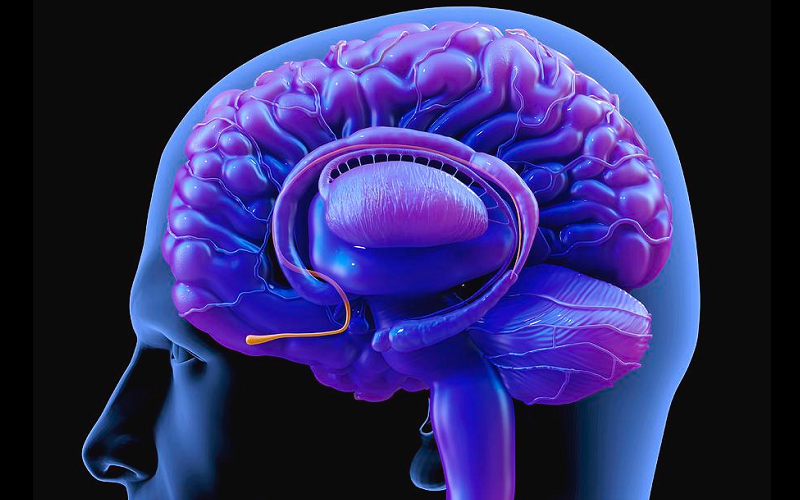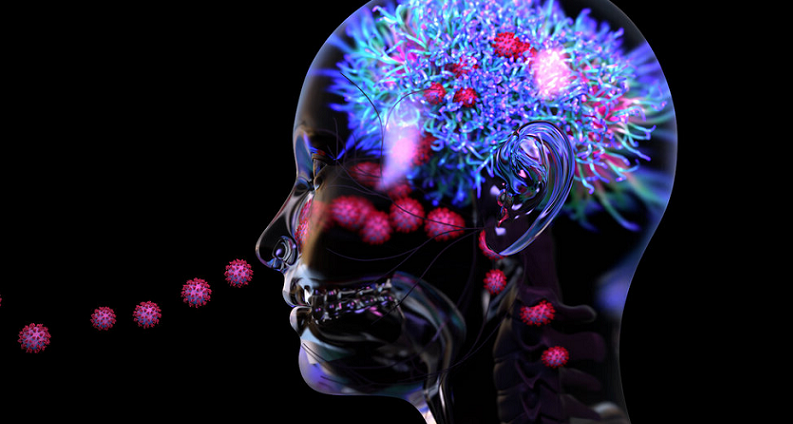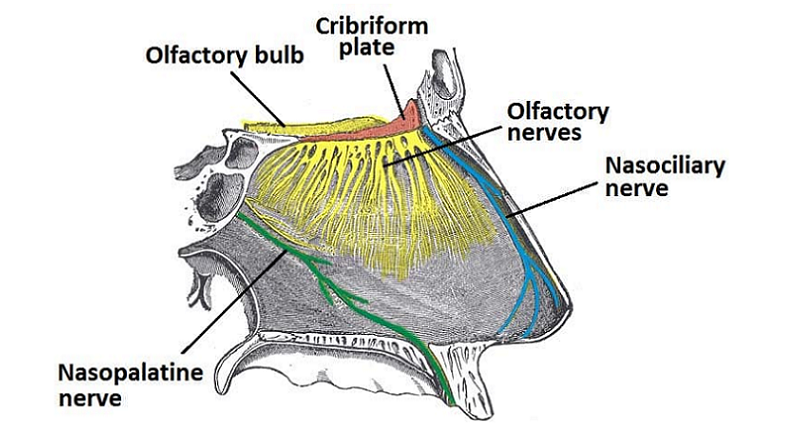
Deep within the intricate structures of the human brain lies a fascinating component, often overshadowed by its larger counterparts: the olfactory bulb. It’s more than just a hub for processing scents; it’s a gateway, connecting the world of smells directly to our deepest memories and rawest emotions. Ever wondered why the faint aroma of freshly baked cookies can instantly transport you back to grandma’s kitchen, or how a certain perfume can evoke a torrent of feelings from a long-forgotten romance? The olfactory bulb holds the answers.
Contents
The Anatomy of the Olfactory System
The human brain, in all its complexity, has specialized systems for each sense. Among these is the olfactory system, tailored specifically for the sense of smell. Delving deep into its anatomy reveals a tapestry of structures and connections intricately wired to decode the world of scents.
Location of the Olfactory Bulb
The olfactory bulb, often likened to a tiny structure resembling a bulb or a teardrop, sits at the very front of the brain, beneath the frontal lobes. Specifically, it’s located right above the nasal cavity. Given its location, it makes sense that this bulb acts as a direct relay station for all the odorous information our nose picks up.
Structure of the Olfactory Bulb
To truly grasp the functioning of the olfactory bulb, it’s vital to understand its structure and the primary cell types within.
Mitral Cells
These are the principal neurons of the olfactory bulb. They receive input from olfactory receptor neurons and play a critical role in processing this information before passing it on to other areas of the brain. Each mitral cell is connected to one specific type of olfactory receptor, ensuring that each scent molecule can be identified distinctly.
Granule Cells
Granule cells are interneurons that communicate directly with mitral cells. Their primary function is inhibitory, helping to refine and modify the signals received from the olfactory receptor neurons. This modulation ensures that our perception of smell is precise and not overwhelmed by a cacophony of odors [1].
Glomeruli
Glomeruli are spherical structures scattered throughout the olfactory bulb. They act as gathering points where axons of olfactory receptor neurons synapse with dendrites of mitral and tufted cells. Think of them as bustling crossroads, directing and sorting myriad odor signals before they head deeper into the brain.
Connection to the Olfactory Nerve and Olfactory Tract
Once the olfactory bulb processes the sensory information, it needs an efficient means to convey it to other brain areas for interpretation and integration. This is where the olfactory nerve and tract come into play.
The olfactory nerve, also known as Cranial Nerve I, comprises a bundle of nerve fibers that connect the sensory receptor cells of the nose to the olfactory bulb. It’s the initial bridge between the outside world and our brain’s perception of scents.
Beyond the bulb, the processed olfactory signals are transmitted to more central parts of the brain via the olfactory tract. This pathway ensures that these odor messages are delivered to areas like the amygdala, hippocampus, and other regions, thereby linking scents to our memories, emotions, and even behaviors.

The Olfactory Process: From Odor to Perception
The journey of an odor, from its origin as a mere molecule in the air to its perception in our brains, is a complex and captivating sequence of events. Each step is a testament to the intricate designs nature has evolved over millions of years to help us make sense of our environment. By examining this process, we can better appreciate the delicate ballet of interactions and transformations that take place every time we take a whiff of our surroundings.
Odor Molecule Detection
Before we can perceive a smell, it must first be detected. And this detection starts at the very place where we breathe.
When volatile molecules (odors) from the environment enter our nostrils, they get trapped in a special layer of mucus situated at the top of our nasal passages. Here, they bind to olfactory receptor proteins located on the cilia of olfactory sensory neurons. Each neuron is tuned to a specific type of molecule, which means every odor has its unique receptor match [2].
Transmission to the Olfactory Bulb
Upon binding, a fascinating molecular dance begins. The interaction between the odor molecule and its receptor triggers a cascade of biochemical events inside the olfactory sensory neuron. This leads to the generation of an electrical signal that races along the neuron’s length.
These olfactory sensory neurons then extend into the olfactory bulb through the olfactory nerve. It is here that the initial processing of the odor begins, setting the stage for more intricate interpretations down the line.
Signal Processing and Relay to Higher Brain Regions
Once inside the olfactory bulb, the signals are met with a flurry of activity. As we explored earlier, glomeruli act as hubs where signals from neurons merge. It’s within these glomeruli that the first level of signal processing occurs. The distinct signals relayed by mitral cells, refined by granule cells, form a unique odor signature—a kind of neural fingerprint for each smell.
The olfactory tract then takes these processed signals onward to other regions of the brain. The primary destinations are the primary olfactory cortex, the amygdala, and the hippocampus. But what’s essential here is that the olfactory system has a direct line to these areas without first relaying its information through the thalamus—a unique feature when compared to our other senses.
It’s in these regions, particularly the cortex, that the final perception of the odor takes shape. Past experiences, current context, and even emotional states play a role in how we eventually perceive and identify a particular scent. Whether it’s the invigorating aroma of morning coffee or the comforting scent of rain on dry soil, the perception is the culmination of this intricate olfactory journey [3].

The Olfactory Connection to Memory
The profound link between scents and memories has been a subject of intrigue for both scientists and poets alike. Who hasn’t been transported back to a distant memory by merely catching a familiar scent on the breeze? This phenomenon is not mere sentimentality; it’s rooted in the anatomy and functionality of our brain’s olfactory system.
Olfactory Pathway to the Hippocampus
One of the most compelling pieces of evidence for the scent-memory connection lies in the olfactory system’s direct route to the hippocampus.
The hippocampus, a seahorse-shaped structure deep within the brain, is critical for forming and retrieving memories. Unlike other sensory information that often requires processing through the brain’s relay station, the thalamus, olfactory data travels directly to the hippocampus. This direct connection allows for a swift and intimate relationship between smells and memory storage.
The Role of the Entorhinal Cortex
Situated between the olfactory cortex and the hippocampus, the entorhinal cortex acts as a bridge, playing a pivotal role in linking odors to memories. The processed olfactory signals pass through this region, getting integrated with other sensory information before reaching the hippocampus. The entorhinal cortex’s involvement ensures that memories associated with scents are richer, consisting of more than just the smell – they evoke emotions, visuals, and even sounds from past experiences.
Proustian Memory: The Phenomenon of Odor-Induced Memories
The term “Proustian Memory” finds its roots in Marcel Proust’s novel, “In Search of Lost Time.” In it, the protagonist reminisces about his past after tasting a madeleine cake dipped in tea. This vivid, almost involuntary recollection of memories triggered by scents is something many can relate to.
Such memories often tend to be more emotional and more vivid than those triggered by other cues. This is because, as we’ve established, the olfactory system is closely tied to the emotional centers of our brain, like the amygdala. The confluence of these pathways ensures that memories evoked by smells are not only clear but also laden with the emotions of the moment when they were first encoded [4].
Scientific Studies Highlighting the Olfactory-Memory Link
Numerous research endeavors over the years have delved into the fascinating connection between scent and memory.
For instance, studies have shown that people can recall memories more accurately and vividly when the same scent present at the time of the memory’s formation is reintroduced. Another interesting piece of research highlighted that our ability to remember scents surpasses our capacity to recall visuals or sounds after a long period.
Moreover, some experiments have demonstrated that scents can even improve memory retention. In controlled environments, participants exposed to particular odors while learning, and then again while sleeping, showed better recall than those who weren’t exposed to any scent.
Emotion and the Olfactory Bulb
The bond between scents and our emotional reactions is intimate and profound. From the calming aroma of lavender to the invigorating scent of citrus, odors have a direct line to our feelings, stirring emotions ranging from joy to nostalgia, and even discomfort. But how does an innocuous molecule in the air tug at the strings of our hearts so potently? The key lies in the olfactory bulb’s intricate connections with our brain’s emotional epicenter.
Olfactory Pathway to the Amygdala
Just as the olfactory system’s pathway to the hippocampus underscores the scent-memory connection, its direct link to the amygdala sheds light on the relationship between scents and emotions.
The amygdala, an almond-shaped structure deep within the brain, is often referred to as the hub of emotions. It plays a central role in processing feelings, especially those related to survival like fear and pleasure. The fact that olfactory information has an unmediated pathway to this emotional core is a testament to the primal and fundamental nature of our reactions to scents [5].
The Emotional Weight of Scents
Every scent carries with it an emotional weight, though the specific feelings it evokes can be intensely personal. While cultural, familial, or individual experiences play a role in shaping these emotional responses, some generalities exist.
For example, floral and natural scents like pine or ocean breeze are often associated with feelings of relaxation and calm. On the other hand, the scent of spoiled food triggers disgust, an evolutionary response to prevent us from consuming potentially harmful substances.
Furthermore, personal experiences heavily dictate our emotional response to particular scents. A fragrance one wore during a summer romance might evoke feelings of warmth and affection, while the same scent could be indifferent or even unpleasant to someone else with different associations.
Evolutionary Significance of Scent and Emotion
The deep-seated connection between scent and emotion is no accident; it’s a product of evolution. Early humans relied heavily on their sense of smell for survival. Detecting the scent of a predator, or the aroma of ripe fruit, could make the difference between life and death.
As a result, our ancestors developed a quick, emotional response to scents – a mechanism ensuring immediate action without the need for prolonged cognitive processing. This evolutionary advantage is why even today, a sudden whiff can instantly evoke powerful feelings before we’re consciously aware of the source of the odor.
References
[1] Olfactory Nerve: Overview, Function & Anatomy
[2] Connectivity and dynamics in the olfactory bulb
[3] Know Your Brain: Olfactory Bulb
[4] Neuronal organization of olfactory bulb circuits
[5] The Olfactory Bulb

